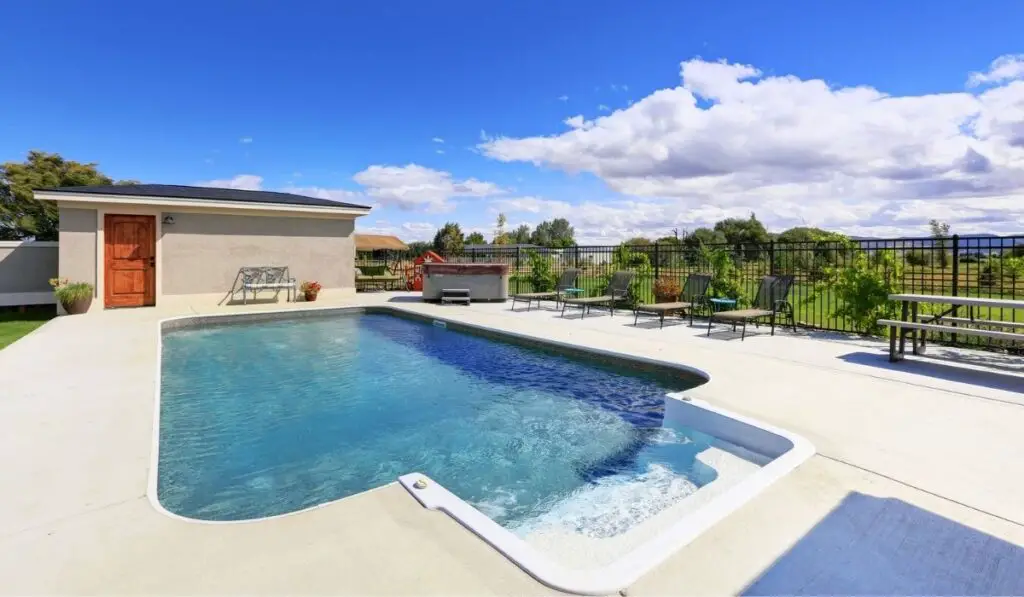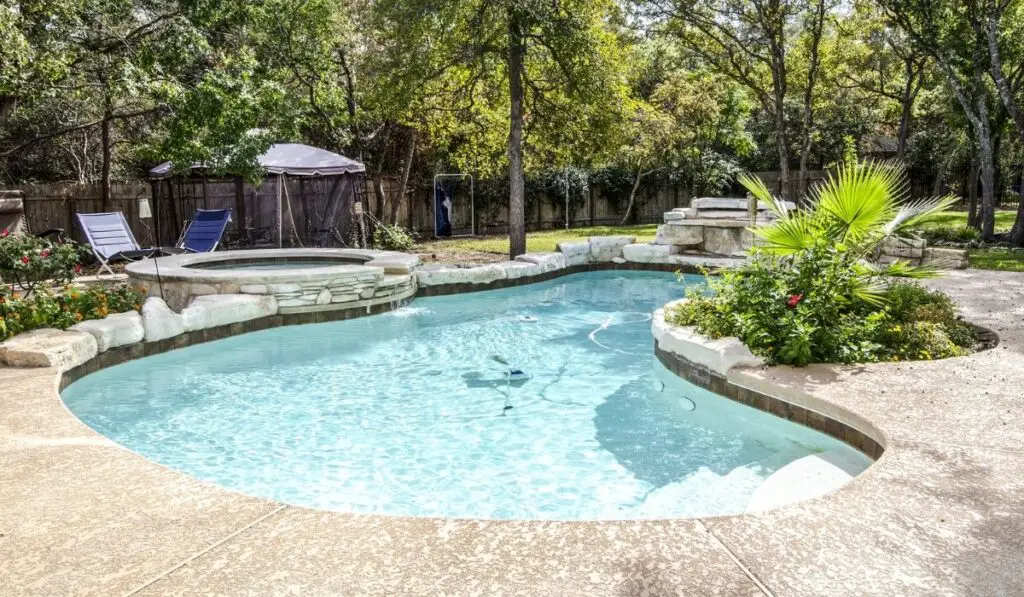Pool owners know how annoying rain and heavy storms can be. These weather conditions can bring debris into the pool and negatively impact the water’s chemistry. So, is it necessary to shock your pool water after it rains to adjust the chemical levels?
Shocking a pool isn’t always necessary after it rains but it is needed to address abnormally high levels of contaminants or to replenish chlorine lost from overflowing during a storm. When in doubt, shocking is a conservative approach after a big storm, but it’s best to check the chemistry first.
Don’t worry if you’ve been shocking your pool after every storm or aren’t quite sure what to do after it rains. Pool maintenance after a storm is fairly straightforward, and you’ll have the hang of it in no time. Here’s what you need to know about shocking a pool after it rains.
Should You Shock Your Pool Before or After It Rains?

Shocking a pool with a simple 1-lb shock product like this one (on amazon) isn’t always necessary after it rains but it is required for if the weather resulted in very high levels of contaminants. Heavy rain impacts a pool’s chemistry and chlorine levels.
Shocking a pool can also replenish the chlorine that was lost during the storm, so whether it’s needed will depend in part on how much rainfall you received and how it impacted the pool water.
Shock Your Pool After It Rains
You can shock your pool after a heavy storm during your cleaning process. One shock treatment won’t fix the water entirely but will help as you continue going through the cleaning procedure. You should shock your pool after turning on the filter and before skimming the water’s surface.
Hopefully, by the time you start adjusting chemicals, the pool shocking treatment will have adjusted the chlorine levels closer to normal.
How to Shock a Pool
The goal of shocking a pool is to increase the free chlorine levels of the pool water to around ten times the combined chlorine level. This mark is the breaking point of chlorination. You’ll need to shock a pool at dusk to ensure the chemicals are working properly. The sun can burn off unstabilized chlorine, causing hiccups in the process.
Here are the basics of how to shock a pool:
- First, test the water. Check the pH level of your pool and the combined chlorine (CC). To find the CC, use a pool test kit (on Amazon) to measure the free-chlorine (FC) and total chlorine (TC). Subtract the FC from the TC to determine how much chlorine is necessary.
- Calculate the amount of pool shock you need to mix. Use the amount indicated on the brand of shock you plan to use. Some varieties of pool shock need to be mixed with water before use. Be sure to wear gloves and safety glasses while using pool chemicals.
- Make sure that your pool pump is running.
- Pour the shock mixture into the water around the perimeter of the pool.
- Allow the pump to run for six hours or more. Refer to your shock brand for the most accurate timing.
- Test the water to determine if you’re at proper chlorine levels.
- Don’t immediately use the pool. Wait for the chlorine levels to drop below 3 ppm, or about 24 hours.
Types of Pool Shock
There are a variety of products you can use to shock a pool. It’s not recommended to use standard chlorine tablets for pool shock.
Calcium Hypochlorite (Cal Hypo): Calcium Hypochlorite is one of the most affordable and convenient ways to shock a pool. It’s typically sold in granular form and needs to be dissolved before adding it to the water. Cal hypo needs to be used after dusk and requires at least eight hours before you can swim safely. This type of shock adds around 0.8 ppm of calcium to the water for every ppm of free-chlorine added.
Lithium Hypochlorite: Lithium Hypochlorite is more costly but doesn’t raise the calcium levels of your pool water. It dissolves much faster and can be added to the power without dissolving beforehand. Commercial options have around 35% chlorine. Lithium Hypochlorite must be used after dusk, requires eight hours before you can swim, and is toxic to aquatic life.
Dichloroisocyanuric Acid (Dichlor): Dichlor is one of the safest and easiest pool shocks to use. This chemical contains around 50-60% chlorine and can be used for both regular chlorine doses and pool shocks. Dichlor adds around 0.9ppm of cyanuric acid for each ppm of additional free-chlorine. It must be used after dusk and requires eight hours before you can swim.
Potassium Peroxymonosulfate: This chemical is a more affordable and non-chlorine type of pool shock. You can add it directly to pool water any time of day. It takes around 15 minutes before you can safely swim, but it’s best to test the levels beforehand. Potassium Peroxymonosulfate cannot be used as an algaecide.
Why You Shouldn’t Shock Your Pool Before a Storm
Some pool owners shock the water, add extra chlorine, or raise the pH levels before rain or a heavy storm. The idea is to increase the pool’s chemical levels to account for the dilution of a storm. Although this sounds good on paper, it’s generally not recommended.
The main reason is that there isn’t a guarantee a storm will be as bad as forecasted. The storm might be weaker, change paths, or resolve early.
Extra chemicals added to your pool can’t be removed. If it doesn’t rain as predicted, the pool’s chemistry will be out of whack and require additional work to reverse the effects.
Pool chemicals don’t come cheap. Adding extra chemicals to a pool before a storm might be unnecessary and, in some cases, you might have to use more chemicals to reverse the effects. It’s best to wait until the storm passes to test the water and adjust accordingly. This way, you’re only adding the chemicals that you need.
What Else Should You Do to Your Pool After It Rains?
Heavy storms don’t just raise water levels and bring twigs, leaves, or other debris into the water. Rainwater can negatively impact a pool’s chemistry and cause damage if left untreated.
Thankfully, there are a few steps you can take after it rains to maintain your pool and its health. Keep in mind that you can adjust these steps and the order to fit your circumstances.
Check Water Levels
The first step you should take after it rains or there’s a heavy storm is to check your pool’s water level. The chances are that your pool’s water level is far above where it used to be or near the middle of your skimmer opening. The filtration and water chemistry can be negatively impacted when a pool’s water levels are too high.
You’ll need to gradually drain your pool using a pool pump if the water is past the middle of the skimmer. Each pump is a bit different, but here are some general steps you can follow:
- Turn your pump to the “Waste” or “Backwash” setting
- Connect the backwash hose to your pump
- Power on the pool pump
- Monitor the water level as the pump drains the water
- Power down your pool pump once the water reaches mid-skimmer level
Turn on the Filter System
Now that the water levels are back to normal, you’ll need to circulate the pool water using the pump. Before you begin, empty out your pool pump and skimmer baskets. Turn your pump to the “Filter” setting.
You can turn on the pump and leave it running as you follow the next steps. The main drain will contribute to some of the cleaning while you handle other problems. You can also turn on the pool heater to warm the water. This is also a good time to get your water testing kit and chemicals ready.
Skim the Surface
Now you can start to skim out any twigs, leaves, or other debris from the water’s surface. If you wait too long, debris can sink to the bottom of the pool floor, causing hassles in the process. If you don’t vacuum, the debris will stay there, causing an unsightly appearance.
You can use a simple pool skimmer (on Amazon) for fishing out any bugs, twigs, or debris. You can also utilize automatic skimmers (on Amazon) to speed up the process, but it’ll cost you.
Brush and Vacuum
Now that you’ve fished out all the debris, it’s time to clean the pool floor, walls, and stairs. These parts might look clean, but they might have picked up contaminants or pollutants from the storm. If you skip brushing and vacuuming, you might have a green or cloudy white pool in the future.
After you’ve finished scrubbing the interior of your pool, connect your vacuum to the skimmer and start cleaning the pool floor. Be sure to vacuum across the full length of the pool. If you have an automatic pool cleaner, you can simply place it in the water and let it work.
If you’re missing a pool vacuum, you can use your brush instead. Push any debris on the pool floor towards the main drain using the brush. The main drain will suck up the debris and send them through the filter.
Test the Water
Now that everything’s all clean, you’ll need to test the pool water. Testing the water and adjusting it accordingly is the most important step. Keeping your water clean is the best way to prevent green water, cloudy surfaces, or other contaminants.
- Inspect the pH levels of your pool. Proper pH ranges fall between 7.4 to 7.6.
- Check the total alkalinity (TA) levels. Good TA ranges anywhere from 80-120 ppm.
- Check the calcium hardness (CH). CH levels should range from 100-300 ppm, with lower numbers being better.
- Inspect the sanitizer or chlorine levels for a minimum of 3 ppm. Levels that are 1-2 ppm higher are generally okay.
Adjust the Chemicals
Now you have a clear idea of which chemicals need adjustments after testing the water. Generally speaking, starting with total alkalinity will help stabilize the pH levels. Afterward, you’ll want to check the pH, calcium hardness, and chlorine/sanitizer.
Adjusting total alkalinity: To increase TA levels, you can use baking soda. To decrease TA levels, use dry acid or muriatic acid (on Amazon).
Adjusting pH levels: You can use soda ash or sodium carbonate to increase a pool’s pH level. To decrease a pool’s pH level, use sodium bisulfate or muriatic acid.
Adjusting calcium hardness: Add calcium chloride (on Amazon) to increase CH levels. Dilute your water to decrease calcium hardness.
How Long Do You Have to Wait to Swim in a Pool After You Shock It?

After a shock treatment, you’ll want to wait until your pool’s chlorine levels are between 1-3 ppm, or 24 hours, before swimming in it again. Be sure to test the water beforehand to ensure you aren’t putting yourself in danger.
Is It Safe to Swim in a Pool After Rain?
Generally speaking, how safe it is to swim in a pool after rain depends on the water chemistry. You’re probably fine to take a dip after skimming the surface if there was only a light drizzle the night before. Moderate to heavy storms require more caution.
Rain can impact the pH levels of a pool, causing the water to become more acidic or more alkaline. Pool water with low pH levels may sting a swimmer’s eyes or nasal passage and cause dry, irritated, and itchy skin. High pH levels can cause irritated eyes, redness, rashes, and dry skin.
After it rains, be sure to test your pool’s water and chemical makeup. Adjust the pH, total alkaline, calcium hardness, and/or chlorine levels before swimming if anything seems off. It’s better to be safe than sorry.
